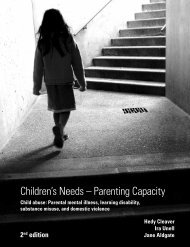Improving Maternal and Infant Nutrition: A Framework for Action
Improving Maternal and Infant Nutrition: A Framework for Action
Improving Maternal and Infant Nutrition: A Framework for Action
You also want an ePaper? Increase the reach of your titles
YUMPU automatically turns print PDFs into web optimized ePapers that Google loves.
IntroductionIn order to change infant feeding practices over time it must be acknowledged fromthe outset that this is not the sole responsibility of the NHS. As with the majority ofissues that pose a threat to population health such as obesity, alcohol <strong>and</strong> drugmisuse, smoking <strong>and</strong> mental ill-health; a co-ordinated, multi-agency, multi-facetedapproach is needed. However, as the NHS is a universal point of entry to servicesavailable to pregnant women, the NHS has a unique opportunity to lead the way inaddressing this from the very early years.We must be clear what we want to achieve with this <strong>Framework</strong>. The two keyrelevant outcomes from the Scottish Government’s National Per<strong>for</strong>mance<strong>Framework</strong> are:• Our children have the best possible start in life <strong>and</strong> are ready to succeed;• We lead longer, healthier lives.The scale of the action needed to achieve these outcomes means that change willnot happen overnight; a long term view is required, there<strong>for</strong>e, the <strong>Action</strong> Plancontained within the <strong>Framework</strong> covers a minimum period of ten years. Clearly a<strong>Framework</strong> <strong>for</strong> improving maternal <strong>and</strong> infant nutrition cannot achieve theseoutcomes alone so it is essential to set the required actions in a much broadercontext of improving population health <strong>and</strong> wellbeing.A central str<strong>and</strong> of the Government’s purpose is to reduce health inequalities. <strong>Infant</strong>feeding patterns in Scotl<strong>and</strong> are poor but are worse in mothers from the mostdeprived areas. Younger mothers, those living on a low income or in areas ofdeprivation <strong>and</strong> those with fewer education qualifications are less likely to take therecommended nutritional supplements prior to pregnancy <strong>and</strong> have a good dietduring pregnancy; they are also less likely to breastfeed <strong>and</strong> more likely to introducecomplementary foods earlier than recommended.There is considerable evidence to demonstrate the short <strong>and</strong> long term benefits ofbreastfeeding to both mothers <strong>and</strong> infants <strong>and</strong> this is likely to lead to a reduced need<strong>for</strong> NHS services in later life. Breastfeeding rates are low in Scotl<strong>and</strong> <strong>and</strong> have beenrelatively static <strong>for</strong> the last decade. It is important to embed work to address thiswithin wider work to improve health in the early years which will have a positiveeffect throughout the life of the individual.Although it is crucial to improve maternal <strong>and</strong> infant nutrition across the wholepopulation, activities must be targeted to those most in need of support. Women aremore likely to breastfeed if they see other women breastfeeding so activities toencourage all women to breastfeed together with a range of activities aimed at thoseleast likely to breastfeed are key components of the <strong>Framework</strong>.Mothers in higher socio-economic groups are more likely to respond to healthcampaigns, access services <strong>and</strong> seek out health in<strong>for</strong>mation, all of which have thepotential to widen inequalities in health. Many people have communicationdifficulties <strong>and</strong>/or literacy difficulties with reading <strong>and</strong> writing <strong>for</strong> example, so our
















